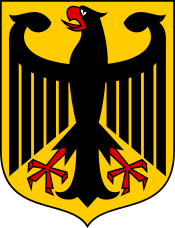German federal election, 1884
| | |||||||||||||||||||||||||||||||||||||||||||||||||||||||||||||||||||||||||||||||||||||||||||
| |||||||||||||||||||||||||||||||||||||||||||||||||||||||||||||||||||||||||||||||||||||||||||
| |||||||||||||||||||||||||||||||||||||||||||||||||||||||||||||||||||||||||||||||||||||||||||
 |
| This article is part of a series on the politics and government of Germany |
|
Constitution ("Fundamental Law Code") |
|
| Foreign relations |
Federal elections were held in Germany on 28 October 1884.[2] The Centre Party remained the largest party in the Reichstag, with 99 of the 397 seats.[3] Voter turnout was 60.5%.[2]
Results
| Party | Votes[a] | % | Seats | +/– |
|---|---|---|---|---|
| Centre Party | 1,282,000 | 22.6 | 99 | −1 |
| German Free-minded Party | 997,000 | 17.6 | 67 | −39 |
| National Liberal Party | 997,000 | 17.6 | 51 | +4 |
| German Conservative Party | 861,100 | 15.2 | 78 | +28 |
| Social Democratic Party | 550,000 | 9.7 | 24 | +12 |
| German Reich Party | 387,700 | 6.8 | 28 | 0 |
| Polish Party | 203,200 | 3.6 | 16 | −2 |
| Alsace-Lorraine Party | 165,600 | 2.9 | 15 | 0 |
| German-Hanoverian Party | 96,400 | 1.7 | 11 | +1 |
| German People's Party | 95,900 | 1.7 | 7 | −2 |
| Danish Party | 14,000 | 0.3 | 1 | −1 |
| Others | 12,700 | 0.2 | 0 | 0 |
| Invalid/blank votes | 18,700 | – | – | – |
| Total | 5,681,700 | 100 | 397 | 0 |
| Registered voters/turnout | 9,383,100 | 60.5 | – | – |
| Source: Nohlen & Stöver, DGDB | ||||
a Figures for votes are rounded.[2]
References
- ↑ Merger of the German Progress Party (60 seats) and Liberal Union (46).
- 1 2 3 Nohlen, D & Stöver, P (2010) Elections in Europe: A data handbook, p762 ISBN 978-3-8329-5609-7
- ↑ Nohlen & Stöver, p789
This article is issued from Wikipedia - version of the 3/12/2014. The text is available under the Creative Commons Attribution/Share Alike but additional terms may apply for the media files.